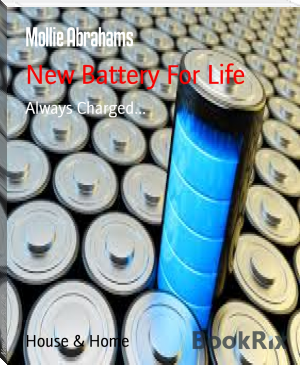New Battery For Life by Mollie Abrahams (english reading book .TXT) 📕

- Author: Mollie Abrahams
Book online «New Battery For Life by Mollie Abrahams (english reading book .TXT) 📕». Author Mollie Abrahams
https://tinyurl.com/Batteries-Learn-how
Because until very recently I believed that no, that it was not possible.
But the last time in Congo, while I was waiting in a workshop, I saw some black people doing some very strange things with the batteries ... and in the end, after a lot of insisting ... they explained it to me.
When a battery is long discharged, or very old, etc ... it is said that it has been "sulphated". Basically, lead and sulfur salts (sulfate-de-lead) are formed which stick to the spongy plate of the negative and plug it all. Normally this battery is considered lost forever.
Start a highly lucrative, expanding and easy to learn business with the highest academic level. You will receive a real kit of materials and measuring instruments with which you can carry out your practical work.
There are thousands and thousands of vehicles circulating daily that need to change batteries regularly in order to continue functioning; To supply this large market. The most important thing about this business is that from batteries that are not working, new battery components can be manufactured, which results in great economic benefits for the manufacturer. No matter if you are male or female or your age, with this course you will learn in an easy and fast way to manufacture and recycle batteries for cars, motorcycles, trucks, buses, etc.
When a battery is long discharged, or very old, etc... it is said that it has been "sulphated" because basically, lead and sulfur salts (sulfate-de-lead) are formed that adhere to the spongy plate of the negative, blocking the chemical reactions. Normally come to this battery is given for lost forever and replaced by a new one.
With a bit of cunning (and especially now that the lead is worth three times more), the old batteries even if they are not lead or gel (NiCD or Lithium ions) can still extend its useful life but how? let's see two methods, the first being useful only for lead batteries or Pb gel and the second best method for all types of batteries (Pb, Pb Gel, NiCd, Li +, etc)
The second method as we will see is the most effective and safe! It can even be useful in case of emergency to recover combinations of alkaline domestic batteries!
Well the question is that modern lead acid batteries or gel electrolyte is gelled and absorbed in the insulators between the plates, which instead of being rigid, is a kind of synthetic cloth, are "maintenance-free" batteries With the passing of time they dry up, the same as when the car batteries ran out of water. So the trick is to remove the rubber plugs under the lid that we already removed and replace it with liquid (it can be two or even three caps, according to the manufacturer).
The method is valid to try to repair gel batteries, composed of acid and lead by simply adding distilled water in their cells to reactivate their original charge but it is also functional for sealed lead-acid batteries. The method works in 90% of the cases but in case of recovering it the battery will work between 50% ~ 70% of the capacity that it had.
There is a very practical, economical and much safer method than the previous method to try to repair all types of batteries (Pb, Pb Gel, NiCd, Li +, etc).
The versatility of the method is such that it can even be used in case of emergency to recover combinations of alkaline domestic batteries, but yes, only "alkaline" batteries, based on this type of batteries, although it seems incredible, in fact if they are rechargeable.
The recuperator and battery charger is based on the fact that the batteries stop accepting charge due to sulfation of the plates, cleaning through this system the sulphate between the plates, reviving the batteries up to 85% when they were new. In 90% of cases they are recoverable for a long time more than using this system.
The circuit as you can see in the diagram below, cannot be simpler, because as we anticipated, only a bridge of power diodes is used (it is very convenient to actually couple a radiator) and a non-polarized capacitor of about 400V (normally used in starting AC motors)
As a very important point, to select the capacitor is that it must be dimensioned so that it does not provide more than 1 / 1o the maximum intensity supported by the battery, that is, the battery must be charged with 10% of the total amperage of the same.
For example, if the battery has a capacity of 10 amps / hour (10AH), the load should be a maximum of 1 amp, regulating precisely this amperage with the capacity of the capacitor (higher capacitance, higher load amperage), resulting in voltage of output that will receive the variable battery going accommodating as it acquires charge.
While we are getting used to the arrival of electric vehicles, the friends and enemies of the manufacturers are introducing us the good and the bad that these batteries have, which we can consider as the most important part of the system. The batteries have a life inside the car, but they can have a longer one outside of it.
All battery types work through a chemical process. Electricity is produced when the internal components of the battery react, and this reaction occurs when the system is switched on. When the engine is running, through the charging system (usually an alternator), the battery recovers its initial state, minus a small percentage of wear. Therefore, this process can be performed a limited number of times (several thousand), so in the end the battery will end up being depleted.
1- Maintenance-free, gel or lithium batteries do not require special maintenance. Only if you lower the load will you agree to plug them into a charger. And anyone is not worth it.
2- The lithium batteries and some of the gel batteries have a charging alarm.
3- Sealed acid batteries require you to pour the electrolyte (acid) into it before mounting it on the motorcycle. Never force that transfer. It will take a few minutes to pass, but avoid acid spills. Then let it rest, without closing the glasses of the battery, between one and two hours.
4- Batteries with maintenance require you to check the electrolyte level. It depends on how you use the bike and where you park it (if it's cold or hot, more often) every two or three months. They are filled with distilled water (not with more acid) up to the maximum level indicated, not up to the top.
5- It is good to protect the terminals of the battery with Vaseline. It is special for this use and protects the batteries from sulphation.
6- Whenever you dismantle the battery, start with the negative pole: if you touch the chassis with the tool, nothing will happen. If the negative connected is touching the positive and the chassis will cause a short circuit that can damage, at least, the protection fuse. When the forest, precisely for the same, begins with the positive.
7- The maintenance acid batteries have a breather tube to evacuate the gases caused in their chemical reactions. That tube you must mount it wherever you go on your motorcycle.
8- If you are going to charge an acid battery, smart chargers are best. If you are going to do it with a normal one, it is best to charge it to the 10th part of its capacity: if you have a 12 Ah battery, charge it at 1.2 amps for 10 or 12 hours. Quick charging options further damage the battery.
9- If you are going to let the motorcycle stop for many days, disconnect the terminals, or remove the battery and keep it at home if there are going to be cold days.
10- If the battery has been discharged for no apparent reason, check the charging circuit of your motorcycle. With a multimeter on the terminals, start the engine. It has to charge between 13 and 14 volts.
11- If you opt for a lithium battery, they are often smaller than normal batteries. They usually come with boosters so that the adjustments to the height of your battery box and does not move.
12- A battery has a limited lifespan: 3-4 years is usual. If you care a lot, you can stretch it to more than four or five, but it's not strange if you have not taken special care of it and "leaves" at half past two.
BRING OLD BATTERIES TO LIFE AGAIN NEW BATTERY FOREVER
ImprintPublication Date: 11-08-2017
All Rights Reserved





Comments (0)